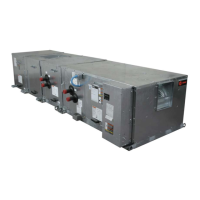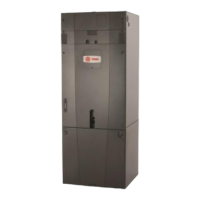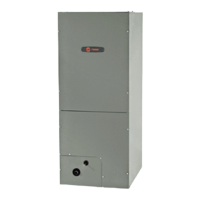LPC-SVX01C-EN 65
Table O-SO-3.
Space temperature control based on communicated request
Request
Note 1
Supply Fan Mechanical Heating Mechanical Cooling Outdoor Air Damper Exhaust Fan
Auto Enabled Enabled Enabled Enabled Enabled
Heat Enabled Enabled Disabled Enabled Enabled
Morning warmup Enabled Enabled Disabled Closed Disabled
Cool Enabled Disabled Enabled Enabled Enabled
Night purge Enabled Disabled Disabled Ventilation disabled Enabled
Economizer enabled
Pre-cool Enabled Disabled Enabled Ventilation disabled Disabled
Economizer enabled
Off Disabled Disabled Disabled Disabled Disabled
Test Enabled Enabled Enabled Enabled Enabled
Emergency heat
Note 2
Enabled Enabled Enabled Enabled Enabled
Fan only Enabled Disabled Disabled Disabled
Note 3
Enabled
Note 1: Enabled means that the controller can use it if needed. Disabled means that the controller cannot use it.
Note 2: The Tracer AH540 controller does not support emergency heat. Emergency heat is treated as Auto.
Note 3: Fan-only operation allows the outdoor air damper to open to its minimum position based on occupancy. Economizing is not allowed.
Figure O-SO-2. Automatic Heat/Cool Changeover Logic Example
Operation
sequence of
operation
Communicated request
A building automation system or peer
controller may communicate the heating
or cooling mode to the controller via
network variables nviHeat- Cool and/or
nviApplicMode. Heating mode
commands the controller to heat only.
Cooling mode commands the controller
to cool only. The Auto mode allows the
controller to automatically change from
heating to cooling or vice versa.
Auto mode
A communicated request of Auto or the
controller default operation (Auto) can
place the unit into heating or cooling
mode. When the controller automatically
determines the heating or cooling mode
while in Auto mode, the unit switches to
the desired mode based on the control
algorithm.
If the Tracer AH540/541 controller is
operating space temperature control, it
uses the space temperature and space
temperature setpoint to automatically
determine heat or cool mode of opera-
tion. When the controller first powers up
or after a reset, it makes an initial
determination if the heat/cool mode
should be heat or cool. If the controller is
configured as heating and cooling, the
controller determines the appropriate
mode.
For example, if the initial space tempera-
ture is less than the occupied space heat
setpoint then the initial heat/cool mode is
heating. The heat/cool mode for a cool-
only unit is always cool. The heat/cool
mode for a heat-only unit is always heat.
When the controller is allowed to auto-
matically determine its space heating and
cooling mode, the unit changes from cool
to heat or from heat to cool, when the
integrated error between the active
space setpoint and the active space
temperature is 900°F seconds or greater.
The integrated error is calculated once
every ten seconds.
See Figure O-SO-2 for an example of the
controller changing from space cooling
(unit mode = cool) to space heating (unit
mode = heat). In this example, the initial
unit mode is cool because the space
temperature is above the cool setpoint,
and the cooling capacity is greater than
0%.
Following the curve from left to right, the
space temperature falls below the cool
setpoint, and the controller reacts by
lessening its cooling capacity. When the
space temperature reaches 1, the cooling
capacity is 0%. The rate at which the
controller reaches 0% capacity depends
on the space temperature rate of change.
Point 1 on the curve in Figure O-SO-2
indicates the point at which the cooling
capacity equals 0%, space temperature is
less than 0.5°F below the cooling setpoint,
and the error integrator starts to add up.
Error integration does not begin until the
capacity is 0%. See the “Heat/cool
changeover: error integration example”.

